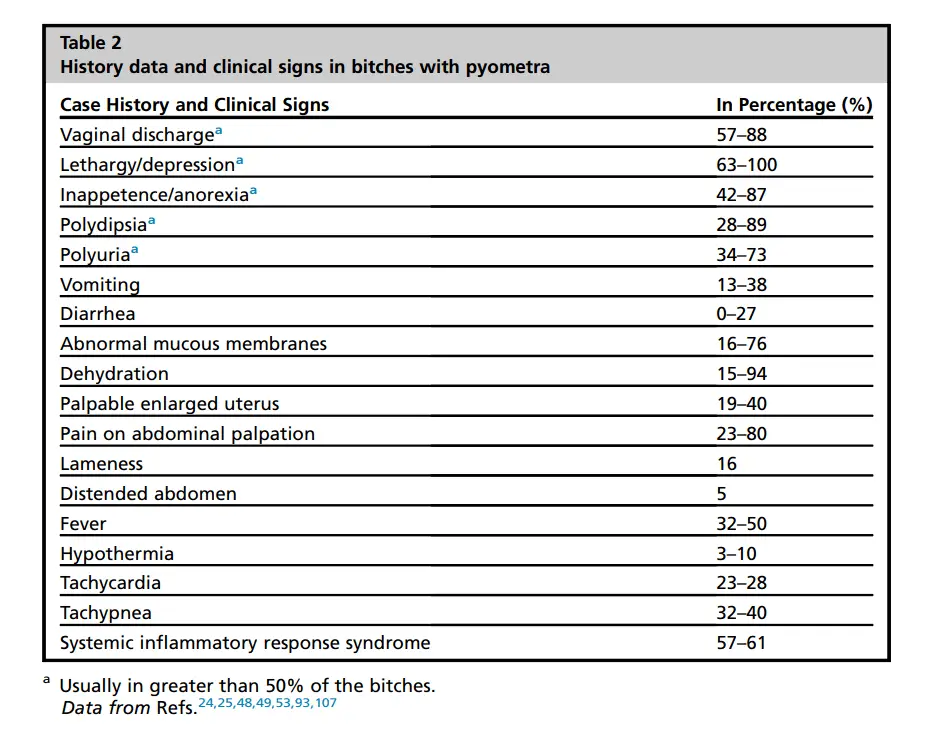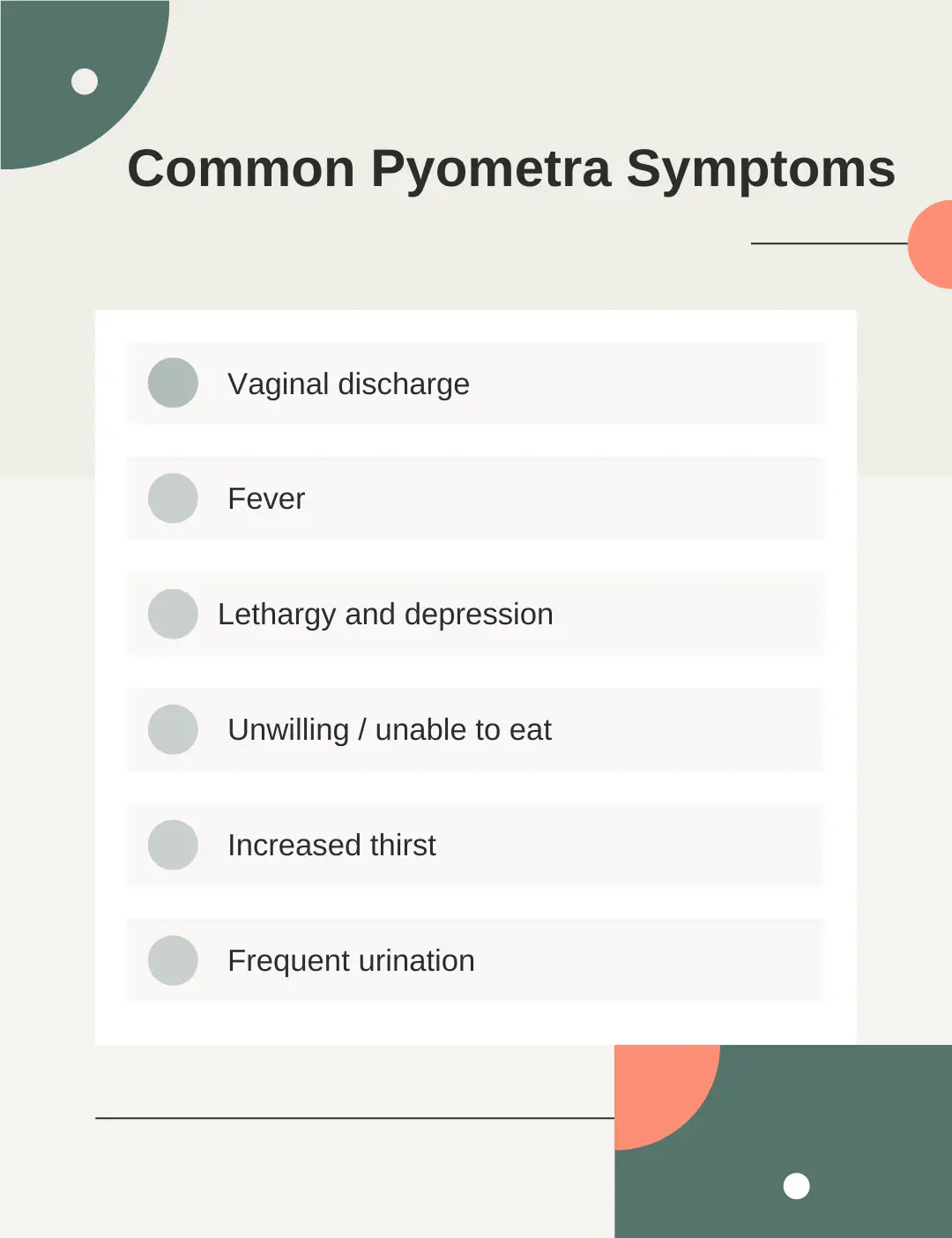Because I wrote a best-selling pet loss book, people often email me with stories of how their dogs died. Recently, someone asked me to write about pyometra in dogs because they'd recently lost their 11-year-old female dog to it. So in honor of that sweet dog, I gathered all the top questions and answers about canine pyometra, which is a potentially life-threatening infection in the uterus. Maybe useful to you now or in the future. Maybe a few stats, symptoms, and risks you didn't know. Plus, one real-life story of a dog who survived pyometra in our family.
More...
What does pyometra mean?
The word pyometra translates as "pus-filled uterus." Ewwww!
What is pyometra?
Pyometra is a potentially life-threatening infection in the uterus, with the risk of causing sepsis.
What is open pyometra?
Open pyometra means the cervix remains open, often leaking a bloody discharge from the dog's vagina.
What is closed pyometra?
Closed pyometra means the cervix remains closed, which traps the infection inside the uterus. Systemic illness and risk is often more severe if the cervix is closed.
What is emphysematous pyometra?
That's when the bacteria off-gases into the uterus further inflating the uterine tissue and increasing the risk of uterine rupture.
This can happen with UTIs as well, so if you ever hear farting noises coming out of any holes that it shouldn't or as your dog is peeing, let your veterinarian know right away.
What is stump pyometra?
Sorry to say that stump pyometra can happen if any residual tissue gets left behind during a spay surgery. Most often that means a small piece of ovary that can still produce hormones remains. And, the infection begins in that general area.
What is the prognosis for dogs with pyometra?
Considering how serious pyometra is, veterinarians save most pyometra patients. The mortality rate ranges from 3% to 20%, depending upon the study cited.
However, about 20% of cases develop complications that increase the risk of severe systemic illness and death. Common complications include:
- Uterine rupture
- Inflammation of the membrane lining the cavity of the abdomen and covering the abdominal organs (peritonitis)
- Sepsis / septic shock (basically the body's reaction to widespread infection)
What are the early signs of pyometra in dogs?
More than 50% of female dogs with pyometra develop these common symptoms:
- Vaginal discharge
- Fever (normal dog temperature approximately 101-102.5)
- Lethargy and depression, meaning they look exhausted and like they don't feel well
- Inappetence / anorexia, meaning they won't / can't eat
- Increased thirst (polydipsia)
- Frequent urination (polyuria)
What other symptoms might dogs with pyometra develop?
- Vomiting
- Diarrhea
- Abnormal mucous membranes (dry / tacky gums, pale gums, bright red gums)
- Dehydration
- Lameness
- Distended abdomen
- Very low body temperature (hypothermia)
- High heart rate
- Rapid breathing / panting
- Systemic inflammatory response syndrome
IMPORTANT!!! Because the risk of uterine rupture is so high, DO NOT go poking around (at all or too hard) on your dog's tummy area if you think she might have pyometra.

Source - Pyometra in small animals
How is pyometra diagnosed?
Classic cases of pyometra in dogs make it easy for veterinarians to diagnose based almost entirely on symptoms, including vaginal discharge and others. Preliminary diagnoses often come from:
- History of symptoms
- Physical and gynecological examination
- Blood work, including hematology and blood chemistry analysis
- X-rays or ultrasound
Cases of closed pyometra can be harder to figure out. Your veterinarian can explain more.
How is pyometra treated?
"Surgical ovariohysterectomy (OHE) is the safest and most efficient treatment..."
How long will my dog live with pyometra?
That depends. It's an emergency, requiring immediate veterinary are. Pyometra in dogs can cause rapid deterioration, and early veterinary intervention likely increases the chances of your dog's survival.
The mortality rate of dogs with pyometra ranges from 3% to 20%.
However, the mortality rate is much higher in dogs that develop more systemic illness and complications.
Can a dog recover from pyometra?
Yes. With immediate treatment, which is typically an emergency spay surgery, most dogs survive and recover. Uncomplicated cases often spend at least a day or 2 recovering post-op at the veterinary hospital, with most markers of illness returning to normal in about 2 weeks. More serious cases may require longer hospitalization and recovery time.
There are non-surgical treatment options for those who hope to later breed a dog with pyometra. It's risky, though, and cases must be selected carefully since it can take up to 48 hours for medical (nonsurgical) treatment to take effect.
How common is pyometra in dogs?
About 20% of all unaltered female dogs develop pyometra before the age of 10. The risk jumps to more than 50% in certain high-risk breeds:
Breeds at Higher Risk of Pyometra
- Rough Collies
- Rottweilers
- Cavalier King Charles Spaniels
- Golden Retrievers
- Bernese Mountain Dogs
- English Cocker Spaniels
How do female dogs get pyometra?
Progesterone plays an important role in the establishment of a pyometra infection in dogs. This typically happens during the during the luteal phase (after ovulation), when progesterone is higher. Basically, the same things that make the body suitable for pregnancy also make bacteria growth more likely.
The most common bacterial pathogen found in female dogs with pyometra is an opportunistic Escherichia coli (e coli) that enters from the outside and works its way into the uterus, where it replicates.
Female dogs with cystic endometrial hyperplasia (CEH) may have an increased risk for developing a pyometra infection in the uterus.
When are female dogs most likely to get pyometra?
While pyometra in dogs can happen in intact female dogs of all ages, as young as 4 months old, it typically happens in middle-age and older dogs, often up to 2 - 4 month after their most recent heat cycle.
How to prevent pyometra in dogs?
Surgical ovariohysterectomy (OHE), often called a spay surgery, before a female dog goes through too many heat cycles is the most common way to prevent pyometra.
While it more often happens in middle-age and older female dogs, pyometra can develop in female dogs as young as 4 months old.
Experience with pyometra in dogs
I've only known one female dog who developed pyometra. It was WAY back when I volunteered onsite at our local animal shelter. I often walked a little sheltie who refused to potty in her kennel, so we needed to take her out often. We kind of became pals, and I convinced my mother-in-law to adopt her. She named her Daisy.
This was before the shelter had veterinarians on staff do spay / neuter all animals before adoption, so we took her to see our DVM at the time.
When they went to do the surgery, Daisy's uterus exploded because it was so full of infection. We're VERY lucky that she survived. They had to rinse out her abdominal cavity and use IV antibiotics. It was pretty scary.
Personal Note: This week (in 2022) happens to be the 10th anniversary of us losing my MIL. Feels both like yesterday and a lifetime ago. So, all hail Daisy and my MIL, gone from our lives, but not from our hearts.







Thank you for this, while it is too late for us and Lucky hopefully it will save some other family the pain that we are experiencing.
I’m so sorry for your loss, James. I really appreciate you reaching out and providing the idea to write about this topic.
Roxanne,
Mercedes had this at 7 months, her breeder was a show person, rarely do they spay their females which disturbs me. We spayed our first two Lhasas ASAP as to avoid pyometra and prevent breast cancer. We took Mercedes to our vet for a wellness check at which time he informed us she was in heat and once it was over she would be spayed. When her heat went on for several weeks the vet knew something was wrong and performed an emergency surgery which he told us up front was dangerous. She was in the hospital for nearly two weeks, were afraid several times we would lose her. During her stay she was given a rabies shot even though she wasn’t due for her adult vaccine for 4 months. After she passed we agreed to give the vets at Blue Pearl her records since she had ongoing health issues for the 11 years we had her. They caught the mistake of her being given the vaccine during her surgical stay and another was given just 4 months later when she was year old. The vet felt she basically had rabies vaccine overdose which caused all her issues. We felt guilty not pressing the original vets for full information concerning her care but they lovingly cared for our first Lhasas, both of which lived to almost 16 and felt to bring that up after she was gone would cause more grief and decided to let it go. Thank God I was given your book which helped me finally accept we did the best for her.
Ugh! I’m sorry she got those 2 doses so close together. I cannot imagine giving a really sick pet *any vaccine, with so much else going on, so many bigger worries. I’m so sorry for your lifetime of worry and stress (and expense) and the grief afterwards.